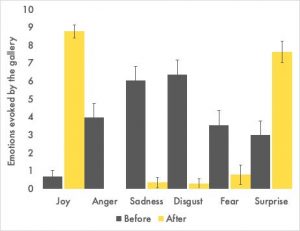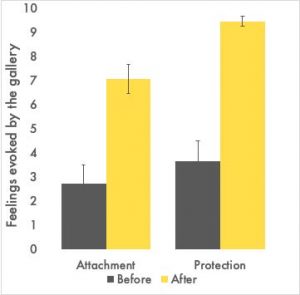Being attached to a place is a natural, widespread and seemingly spontaneous behaviour. Place attachment, which characterizes the cognitive and affective bond that connects people to their environment, is a major drive in determining how people will interact with a place, and react when it is being threatened. Today, globalization, environmental and political crises may endanger place attachment by displacing populations and withdrawing people from the places they have been living in and may be attached to. It has therefore become urgent to get a better understanding of the psychological underpinning of place attachment, and how we can help protect and preserve it in the face of societal, ecological and political adversity.
But what precisely is place attachment, and how has it been characterized by psychologists? Scientific research has converged on the differentiation between the functional and the emotional dimension of place attachment: place dependence and place identity. The former refers to the cognitive functional attachment that arises when a place provide the conditions required to meet an individual’s needs. The latter describes the affective and symbolic importance given to a place as an individual becomes psychologically invested in it1. Both facets offer significant benefits to individuals: place dependence can fulfill individuals’ functional needs and allow them to reach their goals, while place identity can enhance self-esteem and feelings of belonging, reduce anxiety and provide a sense of security2.
Besides increasing the general well-being of individuals and communities, place attachment can also benefit the place itself by operating as a boost for place-protective behaviours3. People with strong place attachment tend to engage in behaviours that help preserve its qualities more often that people less or poorly attached to their environment. For instance, place attachment has been associated with a greater willingness to fight a hypothetical threat or to defend a place from environmental change4. Several studies indicate that place attachment encourage sustainable behaviours and promote the understanding of pro- environmental behaviour5. Also, people who feel strongly attached to a place tend to feel more connected to the local community, and to have better and more extended relations with their neighbours6. They are more likely to show high social trust and to work together to protect the place’s characteristic social and physical features2. In fact, the existence of a community may ultimately depend on people’s individual feeling of attachment to places.
The very notion of community is further thought to be a key determinant of civic engagement and appears to be of particular relevance in the face of the actual ecological crisis that requires the mobilization of a large public. Fostering place attachment could motivate individuals to engage, alone or in groups, in pro-environmental behaviours such as litter picking, recycling, or using soft mobility.
Can place attachment be predicted and fostered? If so, how can this be achieved? Usually, place attachment develops spontaneously over time through repeated interactions with a place and is consistently predicted by factors such as residency length or home ownership. However, it seems that a number of variables can boost the feeling of attachment, as it has notably been evidenced that transient visitors, who have not resided long in a place such as tourists or second home owners, can feel strongly attached to it7. A recent study even suggests that modern means of communication and mobility have facilitated the emergence of new forms of place attachment that do not exclusively rely on direct extended experiences with a place8.
Different interventions could have the potential to foster place attachment, and could be implemented in urban settings. One of the most consistent predictor of attachment to a place appears to be the strength of local social ties or community feeling9. Therefore, urban interventions that contribute to promote community feelings represent relevant levers to foster place attachment. A recent study indicates that participating in short interventions about the history of a local community is associated with increased place attachment and civic engagement in students6. Interest in the local history of a place is positively associated with the perceived continuity of a place, which contributes to a sense of social identity or belonging. Thus, informing new residents about the neighborhood’s history through welcome letters or street signage could promote place attachment and protective behaviours.
Place attachment can also rest on the physical appearance and qualities of a given place. Several studies suggest that one of the main characteristics of a favourite place is its ability to make individuals relax and protect them from the experience of negative emotions10. Natural spaces, by providing rest rather than movement, are highly susceptible to offer a potential for relaxation and restoration. One potential explanation for this effect is that our cognitive functions are less stimulated in natural compared to urban environments, helping mental restoration11. For this reason, the preservation of natural urban spaces appears as a relevant intervention to promote place attachment and place-protective behaviours, especially given the beneficial impact that the experience of nature has on pro-environmental behaviours12.
A last type of urban intervention that can affect place attachment is art. Urban artistic interventions can enhance the aesthetic value of a place, which is associated with place attachment13. In a recent project, we have been able to further explore the link between artististic intervention and place attachment. The UP/SIDE/DOWN/TOWN project that took place in Paris in the summer of 2019 was meant to turn a covered gallery at the corner of a Parisian street into a colorful meeting place14. The project won the “Embellir Paris” competition organized by the Paris City Hall, which aims at embellishing Parisian sites. It was realized by The Street Society, a Paris- based urban innovation agency, and artist Daniel van der Noon. We took this as an opportunity to measure the emotional experience associated to the place and the feeling of attachment, as well as the behavioural intentions to protect the place, in 42 residents of the neighborhood (15 women). The objective of our study was to look into the impact of such intervention, with the hypothesis that it would increase the experience of positive emotions, the feeling of place attachment, and the motivation for place-protective behaviours.
We first collected data regarding the experience of the site before the intervention in 24 local residents, interviewing them as they stopped by the gallery. Since the intervention had just begun, we used photographs to ensure accurate memory recollection, although the residents were all familiar with the place (mean residency length 12.1±12.9 years, range 1-38 years). Three weeks later, as the intervention was almost finalized, we collected data regarding the actual experience of the site in 18 local residents (mean residency length 15.7±12.1 years, range 1-38 years). Participants were notably asked to report how much the gallery evoked a series of emotions on a scale ranging from 0 (Not at all) to 10 (Very much): joy, anger, sadness, disgust, fear and surprise. They were then asked to tell how much the gallery evoked a feeling of attachment and the willingness to protect the place on a scale ranging from 0 (Not at all) to 10 (Very much).
We observed that the site was initially associated with negative emotions, in particular sadness and disgust, mainly due to its poor aesthetic value and the presence of perceived incivilities. At the end of the intervention, we observed a statistically significant increase in emotions of joy and surprise, and a statistically significant decrease in negative emotions, reportedly due to the presence of multiple colours on the walls and ceiling. Interestingly, report of anger completely disappeared post- intervention.

Interestingly, we observed a significant increase in the feeling of attachment to the place, and in the willingness to take care of the place post-intervention.

These results further show that the emotional experience associated with the place has been impacted by the artistic intervention. Interestingly, there was a significant and strong positive correlation between the feelings of joy evoked by the site, the attachment and desire to take care of the site: the more the site evokes joy, the higher the attachment and the willingness to take care of it. Although this case study was done on a limited sample of residents, it suggests that improving place qualities through urban artistic interventions is susceptible to foster place attachment and place-protective behavioural tendencies.
Overall, the present paper underlines the importance of place attachment for the functional and emotional comfort of individuals, as well as for the preservation of urban places. It also stresses the relevance of designing and evaluating urban interventions in order to maximize their beneficial effects on wellbeing and (pro-environmental) behaviours. In the wake of climate change, when 50% of the global population lives in urban places, it seems that cities have a crucial role to play in the promotion of place-protective behaviours. We thus need carefully designed experimental studies to determine which interventions would be the most effective in promoting pro-environmental behaviours in cities.

